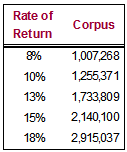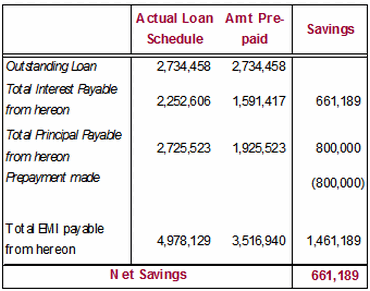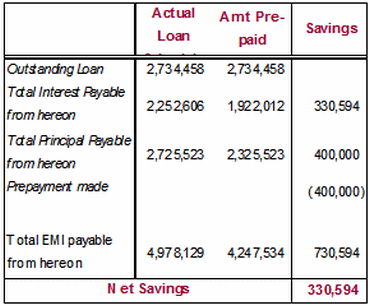 | « Back to article | Print this article |
Got a one-time bonus? Prepay your home loan
Pankaj Nangia, 35, working with an MNC as a project manager received a one-time bonus, a sizeable amount of Rs 8 lakh. He now faced the dilemma of whether to utilise this money to prepay his home loan or to invest.
He had two options:
- Prepay his home loan and reduce the EMI
- Invest the money to enable him to build a sizeable corpus to meet his financial goals
Click NEXT for more...
Got a one-time bonus? Prepay your home loan?
Home loan details
Pankaj, always dreamt of a home with decent comfort and space and had bought an apartment worth Rs 38 lakh in the suburbs of Bangalore, some 7 km away from his office. He had spent an additional Rs 2 lakh for furnishings and fixtures.
He had made a down payment of Rs 8 lakh and had borrowed Rs 30 lakh in early 2008 at a fixed rate of 11.25% per annum for tenure of 15 years. Despite being bombarded with multiple switch options into teaser loans with interest rate of 8% per annum, he did not avail any of it.
He had already paid 36 months of EMI and now had an outstanding loan amount of Rs 27.3 lakh approximately. He now paid Rs 34,500 as EMI, something that felt like a heavy burden on his shoulder and he wished to close this commitment at the earliest.
Click NEXT for more
Got a one-time bonus? Prepay your home loan?
Financial goals and investments
Like any other individual, he wanted an abode of his own, a peaceful retirement and wanted the best for his child, currently aged 2. He bought his house by making a down payment for which he had to dip into some of his lifetime savings that he planned to utilise for his retirement. Now he wanted to replenish such withdrawals to ensure that it did not create a hole in his corpus.
He understood the importance of compounding, the more he delayed, the hole would only get bigger.
The options
The parameters that should guide you in making this decision are:
- Tax savings: Is there an alternate plan for optimisation of taxes?
- Rate of return: Are you able to generate post tax return higher than the stipulated prepayment benefit?
- Financial goal: Which goal are you assigning these funds to? Does it hold greater priority as compared to your housing need?
Click NEXT for more
Got a one-time bonus? Prepay your home loan?
The workings
By using the funds for prepayment of loan, the net savings amounts to Rs 6.61 lakh, with the EMI reducing to Rs 24k per month from the earlier Rs 34.5k per month.
This translates to a savings of Rs 10,147 per month and the could be invested in an avenue yielding 10% per annum, helping to build a corpus of Rs 28 lakh. Potentially, this translates to a corpus of Rs 34.6 lakh (Rs 28 lakh + Rs 6.6 lakh), while the amount deployed would be Rs 8 lakh (onetime) and Rs 14.61 lakh in the form of Rs 10k per month over a 12-year horizon. And all this with his tax savings intact!
In the second scenario, we assume that EMI goes on as per schedule and the amount is invested. Here we provide multiple scenarios to understand when it actually makes sense to choose investments over prepayment of loan:

If the investment were to yield more than 13%, the corpus built (cumulative of net savings on prepayment and corpus built via systematic investment of EMI savings) by means of investments would be greater than by means of prepayment + systematic investments.
Click NEXT for more
Got a one-time bonus? Prepay your home loan?
Another alternate scenario that Pankaj can consider is utilisation of partial amount of the lumpsum towards loan closure and the balance towards investments. This would also result in nominal savings of EMI which can be routed into systematic investments into an avenue yielding 10% per annum (if one were to choose equity mutual funds, the returns could be on the higher side with an average of 15% per annum). The workings of this scenario is illustrated in teh adjoining table.
The EMI savings would amount to Rs 5k per month, which when invested in an avenue yielding 10% would result in a corpus of Rs 14 lakh over the 12-year horizon. The additional Rs 4 lakh if invested, would yield the below mentioned corpus:

If one were to prudently use an avenue yielding higher returns for this amount, one could end up with a scenario substantially higher than the rest of the options. Infact, some of this could also be utilised towards other financial goals such as safety needs -- life / health insurance which are critical, the net outflow in these cases being nominal (almost similar to the EMI savings).
Pankaj has all the scenarios clearly chalked out in front of him; it is now up to him to choose the right option to help maximise his corpus and lighten his EMI burden.
Anil Rego is the founder and CEO of Right Horizons , an investment advisory and wealth management firm that focuses on providing financial solutions that are specific to customer needs.




